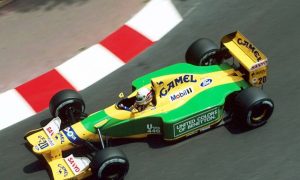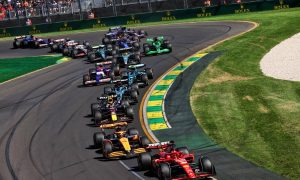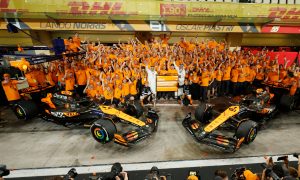They say you shouldn’t talk with your mouth full, but Eric Silbermann risks the wrath of Mrs Manners by having breakfast with a pot-pourri of paddock people.
Apart from the obvious jobs that contribute to this sport there are dozens of folk carrying out vital tasks that no one tends to think about. For example, did you realise there are people whose sole responsibility is looking after the drivers’ helmets? One of these is Peter Buerger and the Japanese GP is the German’s home race given that the firm he works for – Arai Helmets – is based here.
How long have you been in the F1 paddock?
Melbourne ‘97 was my first race so Melbourne 2016 will start my full 20th season.
Always with Arai?
Always with Arai, never missed one race.
Were you working for Arai before they asked you to do Formula 1?
I was a karting racer. I did the European Championship and I went to a motorcycle fair in Cologne, Germany, where I grabbed a folder from a stand of a helmet company that was completely unknown to me, named Arai. I sent a letter to their head office in Europe and said, ‘I like your helmets. Can I get sponsorship?’ They said, ‘We have nobody in karting so it would be a nice idea if you can help us a little bit.’ Arai Europe at this time, 1984, had existed for only 15 months. We started to offer a racing service in karting, which was unusual and in two years, we went from three Arai users up to over 10 or so. By this stage, my karting career was over. I was doing World and European Championship. I raced with Giancarlo Fisichella, and Jos Verstappen and all these blokes so I know them from this time. My best result was 1990, I was fourth in the Europeans, which wasn’t too bad but I understood that my driving abilities were a bit limited compared to other people. For sure I was not as good as Fisichella or Jos or Jarno (Trulli) so I started a little shop called Point Racing, which I still have today, selling all kinds of race gear.
In ’97, the then boss of Arai Europe asked me if I would be interested in taking care of Formula 1 and that’s how I arrived here. But I still remember the eve of my first day in Melbourne, I thought, ‘OK, if it’s going to be like this, I will do three or four races and then I quit. This is too much for me.’
How many drivers did you have?
It was well over 10 but I have no idea really. What I always say is - you might have won 2000 races, you might have been a Le Mans champion, GP2 champion, but when you arrive in this F1 paddock, somebody pushes the big reset button and you start again from nowhere. It needs a lot of patience and good work and the will to do it. From these two or three races that I wanted to do, I’m approaching the 400th.
How many drivers do you look after in the paddock at the moment?
Nine.
And how many helmets would a driver use during a season?
Obviously, from a technical point of view, you can do it with one helmet but mostly they have three, because we’re prepared for all kinds of weather situations, so you have a clear visor, a light smoke one, dark smoke one. So depending if the sun is out or rain is falling we have to be prepared for that.
In the hot conditions, they get very sweaty.
Last week in Singapore, they were changing the helmets during the session so one stays on the drier, the other one will be back in the car. The helmet is the only part of the driver which can be seen out of the car and as everybody knows, they have their own designs and their own colours. The colour scheme of the helmet is the face of the driver in the car and it’s a very, very, very individual item. The overalls, the gloves, the shoes, everything else, belongs to the team but the helmet is his own item.
It’s his signature.
There are very few people who are allowed to touch them and you have, due to the nature of this job, close contact with the drivers, which, for most people, is one of the most important things or the most admirable things in this job. They say ‘You know Sebastian Vettel?’ I say, ‘Yeah but I’ve known him since he was eight years old’. Of course I need to know the drivers because I need to speak to them because they need to tell me what they want or what they like. I’ve lost track of how long I’ve known Jenson for instance. You have to know your babies very well.
Explain what that means - know what they like.
We can modify a little bit but once everything’s fitting well, there’s not much you need to do anymore but for instance, yesterday, (Friday in Suzuka) there was a thick spray on the track so we were driving yesterday in full wet conditions so that means the drivers were using either a yellow or a clear visor, with a double screen for anti-fogging. Then after the session, you have to redo the tear-offs if they used some, clean the helmet also to see if everything is OK. I always feel the job is 50% technical and 50% psychological. Just because I’m there, they feel happy and looked after. The younger ones need advice, for example their first time in Melbourne they think they need a black visor for the sun but I explain they should use a medium one because there’s a lot of trees around, so you go into the shade, into the sun, into the shade and into the sun again.’
Now, I’m working with sons of drivers I worked with in the past, such as Kevin Magnussen and his father Jan. I have Max (Verstappen) and I worked with Jos and I’ve known Max since he was a little baby. Sometimes I have the feeling that I’m a little bit like Uncle Peter at the track because I’ve known the whole family so long.
Do you prepare all the helmets for all the drivers for all the sessions or do some of them like doing some of the work themselves? I’m talking about the tear-offs.
As an example, Will Stevens, I go have a look if he’s alright, but he wants to do all the tear-off stuff himself because it’s a time for him to relax, to concentrate on a different thing. He likes doing it, but I will see him to change one of these carbon panels which is not so easy and I put the drink tubes in for Sunday.
You mentioned the carbon plate. Is that the component which was introduced after Massa’s accident in Hungary?
This is a piece which the FIA applied because obviously the aperture of the visor is still the most vulnerable area. The visor can take a lot but the idea was to bring down the size of the aperture and to reinforce the forehead area. A panel was introduced which is a xylon carbon sandwich construction and it can absorb additional impact energy. It’s stuck on with double-sided special tape so every time we need to change the visor, we have to take the panel off and scratch the double-sided tape away, make new tape, so it’s not just a two-minute job to change the visor.
Teams did look at the aerodynamic effect of the helmets so do helmets vary from team to team or do all your customers have the same Arai helmet shell shape?
I would say 90% have. It was worse with the aerodynamics in the 80s when the cockpit ended halfway up the shoulder and most of the driver was out of the cockpit. Nowadays, the drivers nearly disappear in the car so you don’t see too much of the head anymore. Obviously, the air is streaming over the helmet into the air box and this creates a certain lift because of the speed of the air. To bring the helmet back down again, there’s a small spoiler system which we use but in general, the helmet has to be completely round and as smooth as possible because anything which could stop the helmet from rotating in the case of an accident could cause severe brain damage and really heavy injuries. The philosophy of Arai is that we have to make sure we build a safe helmet. If then we can find an adaption to the car, we will try our best to do that. But we are responsible for the protection of the driver and we cannot follow the ideas of a car designer.
Do you personally have a collection of nice old helmets from the drivers?
Very few. I have a Timo Glock one which he gave to me on my birthday. I have a DC one with some nice words on and I got some nice words as well from Mark (Webber) when he left so let’s say a handful but I think you must also understand that when your life is turning around helmets 24 hours a day, it’s not such... I have enough helmets in my life so it’s not one of the items I’m looking for, without wanting to sound arrogant.
Are some drivers much more difficult to work with than others? Does it take much longer for them to be happy with their helmet than others?
It’s down to how you work and how reliable you are and I personally have in particular no difficult drivers. I had some in the past, but I must admit, I have only had nice ones for quite a while now. Working with them is a pleasure, so I’m a happy man in this paddock.












